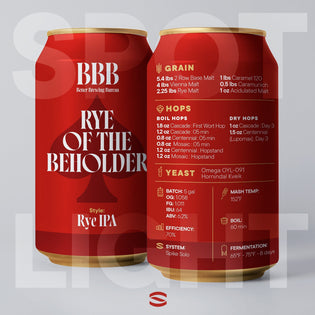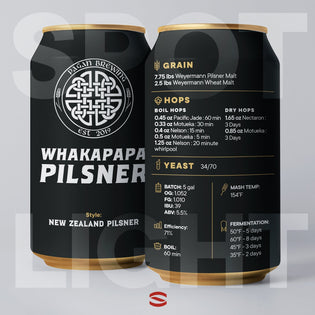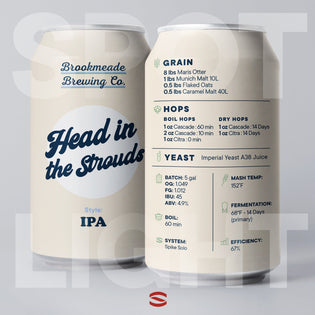
The Brewer: Andrew Galyen
I enrolled in Madisonville Community College’s Fermentation Science program to learn more about the craft, make connections, and meet people, especially brewers who run their own businesses and get to brew every week. I just wanted to be a sponge and absorb all that information. I wanted to try homebrewing for years but couldn’t quite get myself to invest in the equipment. My dad and I decided to go half and half on the equipment and started homebrewing in my garage.
When I find something I like, I dive deep into research, videos, and articles, which is how I found the program at Madisonville. I signed up for more info, and Mike Deal, the program coordinator, got in touch. This has been a great way to learn even more and meet people who have a similar interest and passion for homebrewing.
I graduated last May and was offered a job at Henderson Brewing Company, where I work as an assistant brewer. I got to fulfill a dream of mine—my goal was to start the program, finish it, and find a job in a brewery. But I got lucky and jumped ahead, getting promoted to assistant brewer.
I’ll always be a student, trying to get my hands on whatever new thing I can learn or try, whether it’s a new beer or an interesting book.
The Beer: Doppelbock

The Recipe: Revalator

INGREDIENTS
GRAIN
- 9 lbs Munich I
- 6 lbs Pilsner
- .375 (6 oz) Melanoidin
HOPS
- Boil hops: 0.45 oz Magnum - 0:60 min
- Boil hops: 0.25 oz Tradition - 0:20 min
YEAST
- Saflager W-34/70

INSTRUCTIONS
BATCH SIZE: 5 gal
OG: 1.080
FG: 1.016
IBU: 18
ABV: 8.4%
EFFICIENCY: 75%
MASH TEMP: 154ºF
BOIL: 60 min
FERMENTATION:
50ºF - 21 days
Check out a Brew Day with Spike, Andrew and Madisonville!
Cheers,
Andrew Galyen - Henderson Brewing Company
Spike Summarizes: All Things Doppelbock
What Is a Doppelbock?
Doppelbock, often referred to as "liquid bread," is a strong and flavorful German lager beer style. It is known for its rich malt character, full body, and higher alcohol content. Doppelbock falls under the larger Bock category of beers, which originated in the town of Einbeck, Germany. Doppelbock, as the name suggests, is a "double bock" or stronger version of the traditional Bock beer. This style is characterized by its deep amber to dark brown color, malty sweetness, and well-hidden alcohol strength.
What distinguishes Doppelbock from other beers?
Doppelbock stands out from other beer styles due to its intense maltiness, higher alcohol content, and relatively low hop bitterness. While some beers prioritize hop-forward flavors, Doppelbock showcases the art of malt brewing. It often has complex flavors of caramel, toffee, chocolate, and dark fruit, creating a smooth and robust profile. Its rich malt backbone and higher alcohol content contribute to a warming and satisfying drinking experience, particularly in colder months.
What's the history of Doppelbock beer?
The history of Doppelbock dates back to the 17th century when the Paulaner monks in Munich, Germany, created Salvator, one of the earliest known Doppelbocks. The monks brewed this beer to sustain them during times of fasting, as it provided nourishment and sustenance. "Salvator" means "savior" in Latin, and this beer became a symbol of the monks' brewing skills. Over time, other breweries in Munich and beyond began producing their versions of Doppelbock. Today, this style remains a testament to the rich brewing heritage of Bavaria.
What does a Doppelbock taste like?
Doppelbock offers a complex and layered flavor profile that revolves around its malt-forward nature. The aroma often includes notes of caramel, toffee, dark chocolate, and toasted bread. On the palate, Doppelbock delivers a prominent malt sweetness with flavors of caramelized sugars, molasses, and a hint of dark fruits like raisins and plums. The malt character is balanced by a minimal hop bitterness, allowing the malty richness to shine. Despite its higher alcohol content, Doppelbock is remarkably smooth, making it an approachable option for those new to stronger beers.
How is Doppelbock beer made?
The brewing process for Doppelbock involves the careful selection of ingredients and meticulous attention to detail. It starts with a base of high-quality malted barley, often including Munich and Vienna malts that contribute to the beer's rich color and maltiness. The brewing process includes mashing, boiling, lautering, and fermentation. During mashing, the grains are mixed with water to convert starches into fermentable sugars. The resulting wort is then boiled with hops for bitterness and aroma. After boiling, the wort is cooled and yeast is added for fermentation. Doppelbock typically undergoes a longer fermentation and conditioning period to allow its flavors to develop fully.
What are the essential ingredients in Doppelbock?
The essential ingredients in Doppelbock include malted barley, hops, yeast, and water. Munich and Vienna malts play a vital role in creating the beer's rich and complex malt character. These malts contribute to the beer's deep color and flavors of bread, caramel, and toffee. Noble hops, such as Hallertau or Tettnang, are used sparingly to provide a mild bitterness and balance to the malt sweetness. Yeast strains used in Doppelbock fermentation are often lager yeast varieties that work at cooler temperatures, contributing to a clean and well-rounded flavor profile.
What foods go best with Doppelbock?
Doppelbock's malt-forward and slightly sweet nature makes it a versatile pairing with a variety of foods. Its rich flavors complement hearty and savory dishes, making it an excellent choice for robust meals. Classic pairings include roasted meats like pork, sausages, and game meats. The beer's caramel and toffee notes harmonize with caramelized flavors in dishes like roasted vegetables and barbecue. Doppelbock can also cut through the richness of cheese, particularly aged cheddars, Gouda, and blue cheese. For dessert, consider pairing Doppelbock with chocolate desserts, caramel flan, or pecan pie for a delightful combination of flavors.
Is Doppelbock a year-round beer?
Doppelbock's rich and warming qualities make it a popular choice during the colder months of the year. Its malt-forward profile and higher alcohol content provide a comforting and satisfying drinking experience, particularly in fall and winter. However, Doppelbock can be enjoyed year-round by those who appreciate its complex flavors and robust character.
How strong is a typical Doppelbock?
Doppelbocks are known for their higher alcohol content, which contributes to their full-bodied and warming nature. Typically, Doppelbocks have an alcohol by volume (ABV) ranging from 7% to 12%, although some versions may go even higher. This elevated alcohol content is balanced by the beer's malt sweetness and flavor complexity, creating a beer that is both flavorful and enjoyable to drink.
Are there different types of Doppelbock beers?
While Doppelbock itself is a distinct beer style, there are variations and substyles within the category. One well-known substyle is Eisbock, which is a stronger and more concentrated version of Doppelbock achieved through a process of freezing and removing ice to increase alcohol content. Additionally, some breweries create barrel-aged Doppelbocks, where the beer is aged in oak barrels, often previously used for spirits like whiskey. This aging imparts additional layers of flavor, including vanilla, oak, and sometimes subtle whiskey notes.
What's the correct temperature for serving Doppelbock?
Doppelbock is best enjoyed at a slightly cooler temperature than typical lagers, around 50-55°F (10-13°C). This temperature range allows the beer's flavors to be fully appreciated without being overly chilled, which could mask its complexity. Serving Doppelbock at a slightly warmer temperature also enhances its aromas, allowing the malt-driven characteristics to shine.
What are some popular brands of Doppelbock?
Several breweries produce exceptional Doppelbocks that showcase the style's unique qualities. Some well-regarded examples include:
- Ayinger Celebrator: Hailing from Germany, Ayinger's Celebrator is a classic example of Doppelbock, known for its rich maltiness and dark fruit notes.
- Weihenstephaner Korbinian: Another German brewery, Weihenstephaner, offers the Korbinian Doppelbock with flavors of caramel, chocolate, and a touch of roastiness.
- Paulaner Salvator: One of the original Doppelbocks, Paulaner's Salvator showcases the style's history and tradition, featuring malt-forward flavors with a slightly nutty character.
These are just a few examples of the many Doppelbocks available from breweries around the world.
Why does Doppelbock have a strong malt character?
The strong malt character of Doppelbock is a result of the brewing process and the use of specific malt varieties. Munich and Vienna malts, which are rich and flavorful, form the base of Doppelbock recipes. These malts contribute to the beer's deep color and provide a complex range of malt-derived flavors, including caramel, toffee, and dark fruit. The combination of these malts with careful brewing techniques creates the pronounced maltiness that defines Doppelbock.
How does the brewing process affect Doppelbock's flavor?
The brewing process plays a significant role in shaping Doppelbock's flavor profile. The use of Munich and Vienna malts contributes to the beer's malt-forward character, infusing it with flavors of toasted bread, caramel, and dark fruit. The longer fermentation and conditioning period often employed in Doppelbock production allow the beer's flavors to develop fully, resulting in a smooth and well-rounded taste. Additionally, the cooler fermentation temperatures associated with lager yeast strains used in Doppelbock brewing contribute to a clean and balanced flavor profile.
Are Doppelbocks more bitter than other beers?
Doppelbocks are characterized by their malt-forward nature and relatively low hop bitterness. While they do contain hops, the emphasis in Doppelbocks is on the complex flavors derived from malt. The hop bitterness is generally subdued, allowing the beer's malt sweetness and rich flavors to take center stage. As a result, Doppelbocks are not considered particularly bitter compared to hop-forward styles like IPAs.
Why is Doppelbock often served in a specific type of glass?
Doppelbocks are often served in glassware that enhances their aroma and flavor presentation. The most common glassware choice for Doppelbocks is a tulip-shaped glass. This glass has a bulbous bottom that narrows towards the top, allowing the beer's aromas to collect while funneling them towards the drinker's nose. This design helps capture the complex malt aromas and allows for a more immersive tasting experience.
Is Doppelbock beer good for beginners?
Doppelbock's rich and malt-forward profile may make it a more acquired taste for beginners who are not accustomed to stronger and more complex beers. Its full-bodied nature and higher alcohol content can be overwhelming for those new to craft beer. However, individuals who appreciate malt-forward flavors and are looking to explore more robust beer styles may find Doppelbock to be a rewarding choice.
What is the ideal glass temperature for Doppelbock?
To fully appreciate the flavors and aromas of Doppelbock, it's recommended to serve it in a glass that has been chilled to around 50-55°F (10-13°C). This temperature range allows the beer's complexity to shine without being overly cold, which could mask its nuanced characteristics. It's worth noting that serving Doppelbock too cold could diminish its flavors, so avoid excessively low temperatures.
Where can I buy the best Doppelbock beers?
Doppelbock beers can be found in various craft beer shops, liquor stores, and some specialty supermarkets. Additionally, many breweries produce Doppelbocks seasonally or as part of their regular lineup. To find the best Doppelbocks in your area, consider visiting local craft beer establishments, checking online beer retailers, or contacting breweries directly to inquire about availability.





